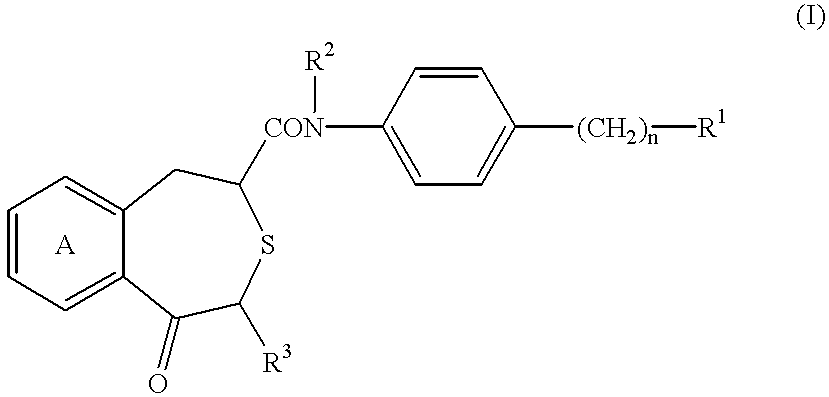Benzothiepin derivatives, process for the preparation of the same and uses thereof
a technology of benzothiepin and derivatives, applied in the field ofbenzothiepine derivatives, can solve the problems of bone resorption suppressors not achieving satisfactory effects, and achieve the effects of promoting osteogenesis, low toxicity, and superior clinically useful characteristics such as stability
- Summary
- Abstract
- Description
- Claims
- Application Information
AI Technical Summary
Benefits of technology
Problems solved by technology
Method used
Image
Examples
reference example 1
Preparation of 3-(4-Aminobenzyl)-2,4-dioxothiazolidine
To a solution of 4-nitrobenzyl bromide (8.00 g) and potassium carbonate (7.68 g) in N,N-dimethylformamide (DMF)(80 ml) was added 2,4-thiazolidinedione (6.51 g), and the mixture was stirred at room temperature for 14 hours. Insoluble material was filtered off, and the mother liquor was evaporated under reduced pressure. The residue was dissolved in ethyl acetate, and washed with diluted hydrochloric acid, water and saturated brine, successively. The solution was dried (MgSO.sub.4) and evaporated under reduced pressure, and the precipitated crystals were collected by filtration under suction to give 3-(4-nitrobenzyl)-2,4-dioxothiazolidine (8.45 g, 34%).
In a mixture of ethanol (400 ml) and ethyl acetate (400 ml) was dissolved 3-(4-nitrobenzyl)-2,4-dioxothiazolidine (8.25 g), to which was added 5% palladium-carbon (2.00 g), and the mixture was stirred in hydrogen atmosphere at room temperature for 8 hours. Insoluble material was filt...
reference examples 2-8
According to the same manner as in Reference Example 1, the compounds shown in the following Table 1 were obtained.
reference example 9
Preparation of 5-(4-Aminobenzyl)-2,4-oxazolidinedione
To a solution of methyl 3-(4-aminophenyl)-2-hydroxy-propionate (4.50 g) and triethylamine (3.2 ml) in acetonitrile (50 ml) was added benzyloxycarbonyl chloride (5.9 ml) under ice cooling, and the mixture was stirred at room temperature for 30 minutes. The reaction mixture was poured into water and extracted with ethyl acetate, and the ethyl acetate layer was washed with an aqueous ammonium chloride solution, water, saturated sodium hydrogencarbonate aqueous solution, and saturated brine, successively, and dried (MgSO.sub.4). Solvent was distilled off under reduced pressure, and the residue was purified by silica gel chromatography to give methyl 3-(4-benzyloxycarbonylaminophenyl)-2-hydroxypropionate (5.61 g, 74%). To a solution of 3-(4-benzyloxycarbonylaminophenyl)-2-hydroxypropionate (4.88 g) in tetrahydrofuran (THF)(120 ml) was added 2N potassium hydroxide aqueous solution (14 ml) under ice cooling, and the mixture was stirred a...
PUM
| Property | Measurement | Unit |
|---|---|---|
| optical purity | aaaaa | aaaaa |
| temperature | aaaaa | aaaaa |
| temperature | aaaaa | aaaaa |
Abstract
Description
Claims
Application Information
 Login to View More
Login to View More - R&D
- Intellectual Property
- Life Sciences
- Materials
- Tech Scout
- Unparalleled Data Quality
- Higher Quality Content
- 60% Fewer Hallucinations
Browse by: Latest US Patents, China's latest patents, Technical Efficacy Thesaurus, Application Domain, Technology Topic, Popular Technical Reports.
© 2025 PatSnap. All rights reserved.Legal|Privacy policy|Modern Slavery Act Transparency Statement|Sitemap|About US| Contact US: help@patsnap.com



